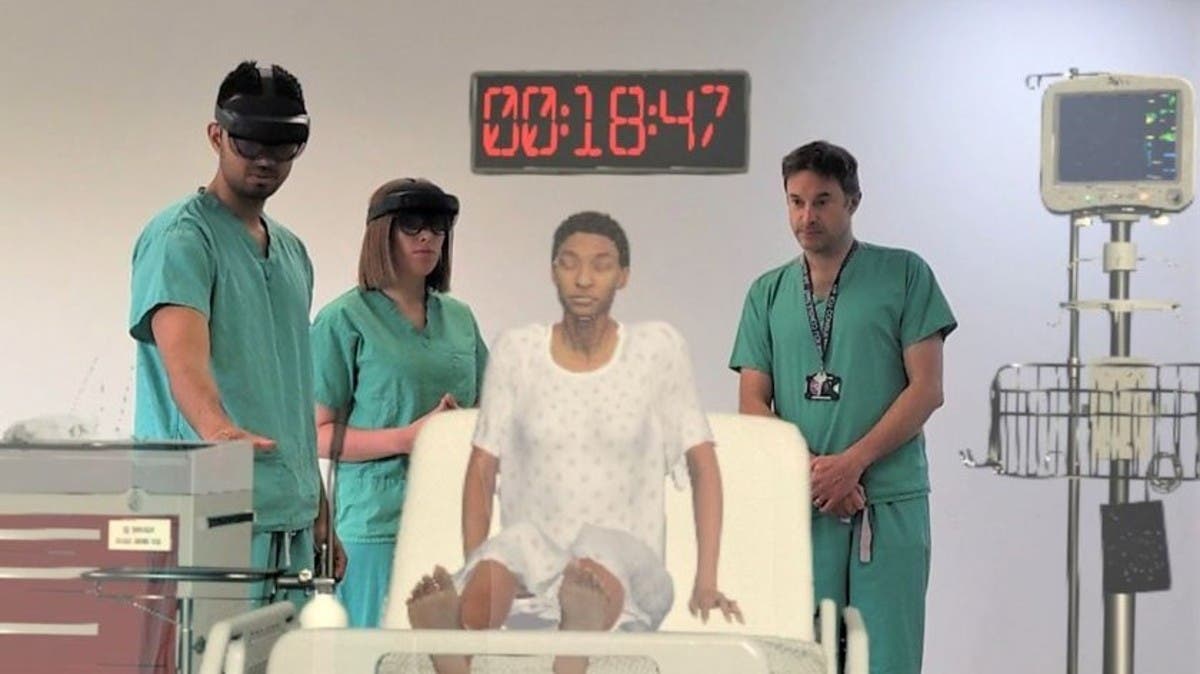A hospital in the United Kingdom has become the first in the world to train its future doctors with the use of holographic patients.
Researchers at the Addenbrooke’s Hospital in Cambridge have developed mixed-reality technology that can mimic medical situations for students through which they can treat virtual patients.
For the latest headlines, follow our Google News channel online or via the app.
During these simulations, medical students encounter a virtual patient experiencing symptoms and must make decisions on how to care of it in real-time.
The students wearing the mixed-reality headsets are able to see each other in real life, while also interacting with a multi-layered, medically accurate holographic patient, a statement by Cambridge University Hospitals said. This enables an environment where medical students can learn and practice vita decision making and treatment in real-time.
The new mixed-reality training application, HoloScenarios, is being developed by Cambridge University Hospitals National Health Service Foundation Trust (CUH) in partnership with the University of Cambridge and Los Angeles-based technology company GigXR.
NHS medical director Sir Stephen Powis said that this new technology “could enhance the learning experience of our next generation of doctors, nurses and healthcare workers, by creating new environments to practice medicine in real-time, while improving access to training worldwide.”
Through the same type of mixed-reality headset, medical instructors can alter patient responses, introduce complications to the simulations, and record observations and discussions. This can be conducted in person within a teaching group or remotely, and can be done in various locations worldwide via the internet.
“This makes training much more interactive and realistic, and you can safely make mistakes and learn from them,” said CUH junior doctor Aniket Bharadwaj.
“Throughout medical school we would have situations where actors would come in an act as patients. With the pandemic a lot of that changed to tablet-based interactions because of the risk to people of the virus.”
Learners can watch, contribute to and assess these patient scenarios from their Android or iOS smartphones, or tablets. The technology is now available for license to learning institutions all over the world.
The first module features a hologram patient with asthma, followed by anaphylaxis, pulmonary embolism and pneumonia, the statement revealed, adding that further modules in cardiology and neurology are now in development.
“Mixed reality is increasingly recognized as a useful method of simulator training. As institutions scale procurement, the demand for platforms that offer utility and ease of mixed reality learning management is rapidly expanding,” said the project’s leader Dr. Aruna Gupta, who is also a consultant anesthetist at CUH and director of postgraduate education at Cambridge University Health Partnership.
The new technology provides an opportunity for more flexible, cost-effective training without heavy resource demand of traditional simulations, which can make immersive training financially prohibitive.
“Empowering instructors with 360-degree preparation for clinical practice represents a milestone for GigXR that allows us to provide our customers with a library of applications that offers solutions for students from their first courses to continuing education,” said GigXR founder David King Lassman.
“Our first HoloScenarios module represents a new and incredibly powerful way to use mixed reality for healthcare training, to be followed up by many more modules and new applications delivered soon.”
Read more:
Scientists develop ‘acoustic fabric’ that can ‘hear’ your heartbeat
Metaverse will lead to evolution of ‘virtual babies’ who grow up in real time: Expert
UAE, Saudi to be ‘major players’ in Metaverse; will invest and reap billions: Expert


 World3 years ago
World3 years ago
 World3 years ago
World3 years ago
 Business1 year ago
Business1 year ago
 Entertainment7 years ago
Entertainment7 years ago
 World7 years ago
World7 years ago
 Entertainment7 years ago
Entertainment7 years ago




